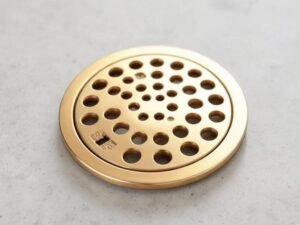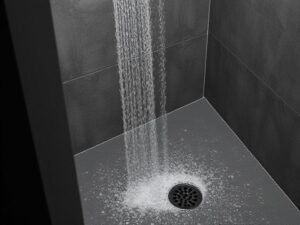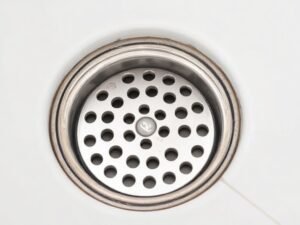Opening
Bathroom renovations in Europe’s older buildings often present unique challenges, particularly when it comes to floor height limitations. When every millimeter matters, traditional shower drains can make the difference between a successful renovation and a costly reconstruction project. Ultra-thin shower drains have emerged as the game-changing solution for these space-constrained scenarios, offering both functionality and aesthetic appeal without requiring extensive structural modifications.
Snippet
Ultra-thin shower drains typically feature installation heights of 50-70mm compared to traditional drains requiring 100-150mm, making them ideal for renovation projects with limited floor height. The S01 Series ultra-thin shower drain combines a remarkably slim profile with a 45L/min flow rate, solving the common renovation challenge of drainage installation in low-clearance spaces while maintaining high performance standards and contemporary aesthetics.
Transition
Before diving into the technical specifications of modern ultra-thin drainage systems, let’s understand why these innovative solutions have become increasingly popular across European renovation projects, particularly in heritage buildings and apartments where structural modifications are either restricted or prohibitively expensive.
The S01 Series requires just 50-70mm height clearance versus the 100-150mm needed for standard drains, making renovation possible without extensive floor modifications.
304/316 grade stainless steel in the S01 Series resists corrosion in high-moisture environments, significantly outlasting plastic alternatives commonly used in standard drains.
Despite its slim profile, the S01 Series achieves an impressive 45L/min drainage capacity, meeting or exceeding European standards for shower drainage performance.
Narrower than conventional drains, ultra-thin models increase usable shower space while maintaining required drainage functionality.
Section 1: Why Floor Height Matters in European Bathroom Renovations
Renovating bathrooms in Europe’s architectural heritage presents unique constraints unlike those in newer constructions. Historical buildings, particularly those built before the mid-20th century, typically feature floor structures with minimal clearance between joists or concrete slabs. This limited vertical space creates significant challenges when installing modern plumbing systems.
The average floor height in European historical buildings allows for only 50-70mm of installation depth without major structural modifications. Traditional shower drains, requiring 100-150mm vertical clearance, often necessitate expensive and disruptive floor raising or joist modifications that can compromise structural integrity and historical value.
Transition: Understanding these structural limitations explains why ultra-thin drainage solutions have become essential tools in the modern renovation specialist’s arsenal, particularly when working with protected buildings or budget-conscious projects.
Section 2: What Makes Ultra-Thin Shower Drains Different from Standard Models?
Comparative Table: Ultra-Thin vs. Standard Shower Drains
| Feature | Ultra-Thin Drains (S01 Series) | Standard Shower Drains |
|---|---|---|
| Installation Height | 50-70mm | 100-150mm |
| Channel Width | 35mm | 65-80mm |
| Flow Rate | 45L/min | 30-60L/min |
| Material | 304/316 Stainless Steel | Varies (often plastic/steel composite) |
| Suitable for Renovations | Excellent | Limited |
| Design Aesthetic | Modern, minimalist | Variable |
| Barrier-Free Installation | Ideal | Challenging |
| Price Range | €120-350 | €60-250 |
The fundamental difference lies in the engineering approach. Ultra-thin drains utilize specialized water traps and horizontal outlet designs that dramatically reduce vertical space requirements while maintaining necessary water seals to prevent odor backflow.
Transition: While the dimensional advantages are clear, many contractors question whether these space-saving designs compromise drainage performance – an important consideration for both residential and commercial applications.
Section 3: How Do Ultra-Thin Drains Maintain Performance Despite Their Slim Profile?
Contrary to intuition, modern ultra-thin drains like the S01 Series achieve impressive flow rates despite their compact dimensions. This performance is possible through several engineering innovations:
- Optimized Water Trap Design: Redesigned water seals maintain odor protection while reducing vertical space requirements.
- Precision Manufacturing: Tighter tolerances and smoother channel surfaces reduce flow resistance.
- Flow Dynamics Engineering: Computer-modeled water flow patterns maximize drainage efficiency.
- Strategic Outlet Positioning: Horizontal outlets eliminate the need for vertical drops while maintaining gravity-assisted flow.
These innovations allow the S01 Series to achieve a 45L/min flow rate – exceeding the European standard EN 1253, which requires a minimum flow rate of 30L/min for shower drains.
Transition: Understanding the technical performance capabilities of ultra-thin drains helps identify which renovation scenarios benefit most from these specialized solutions.
Section 4: Which Installation Scenarios Benefit Most from Ultra-Thin Drainage Solutions?
Quiz: Is an Ultra-Thin Shower Drain Right for Your Project?
- Is your renovation in a building older than 50 years? a) Yes (+3 points) b) No (0 points)
- What is the available floor height for drain installation? a) Less than 70mm (+5 points) b) 70-100mm (+3 points) c) More than 100mm (0 points)
- Are there restrictions on modifying floor structure? a) Yes, significant restrictions (+4 points) b) Some limitations (+2 points) c) No restrictions (0 points)
- Is barrier-free/accessible design required? a) Yes, full compliance needed (+4 points) b) Preferred but not mandatory (+2 points) c) Not required (0 points)
- What is the project budget sensitivity? a) Cost-sensitive, avoiding structural changes is priority (+3 points) b) Moderate budget flexibility (+1 point) c) Budget allows for structural modifications if needed (0 points)
Results:
- 15-19 points: Ultra-thin drain strongly recommended
- 10-14 points: Ultra-thin drain likely beneficial
- 5-9 points: Consider based on specific circumstances
- 0-4 points: Standard drain may be sufficient
Ultra-thin drains provide particular advantages in:
- Historical building renovations
- Apartment retrofits with concrete slab floors
- Accessible/barrier-free bathroom designs
- Projects with strict height restrictions
- Renovations seeking to minimize structural modifications
Transition: Beyond installation constraints, material selection plays a crucial role in determining the long-term performance and value proposition of ultra-thin drainage solutions.
Section 5: What Material Considerations Matter for Long-Term Drain Performance?
The S01 Series employs premium 304/316 stainless steel construction, offering significant advantages in the challenging bathroom environment:
- Corrosion Resistance: 316-grade stainless steel contains molybdenum, providing superior protection against chlorides found in cleaning chemicals and water supplies throughout Europe.
- Thermal Stability: Maintains structural integrity despite temperature fluctuations between hot showers and cold water.
- Hygienic Properties: Non-porous surface prevents bacterial growth, meeting stringent European hygiene standards.
- Weight-Bearing Capacity: Despite the thin profile, properly designed stainless steel grates support up to 300kg, exceeding residential and light commercial requirements.
- Longevity: Expected service life exceeds 15 years in typical bathroom environments, compared to 5-8 years for plastic alternatives.
Transition: While technical performance is critical, the aesthetic impact of drainage solutions has become increasingly important in contemporary European bathroom design.
Section 6: How Do Ultra-Thin Drains Impact Overall Bathroom Design?
The minimalist profile of ultra-thin drains like the S01 Series creates new design possibilities previously constrained by bulkier traditional drains:
- Seamless Transitions: The minimal height difference allows for smoother transitions between shower areas and the main bathroom floor.
- Material Continuity: Thinner profiles enable the use of the same tiles throughout the bathroom, creating visual continuity.
- Barrier-Free Design: Ultra-thin drains facilitate zero-threshold showers, essential for accessible design and increasingly popular in contemporary European bathrooms.
- Design Flexibility: The 35mm channel width of the S01 Series is less visually intrusive than traditional drains, allowing the flooring material to become the dominant design element.
- Aging-in-Place Considerations: The barrier-free installation possibility addresses the growing European market for age-friendly home renovations.
Transition: While the design and performance advantages are compelling, contractors and installers should be aware of specific installation considerations when working with ultra-thin drainage systems.
Section 7: What Installation Challenges Should Contractors Anticipate?
Despite their advantages, ultra-thin drains require attention to specific installation details:
- Precise Floor Slope: With reduced height comes less margin for error in establishing the 1-2% slope required for proper drainage.
- Waterproofing Integration: The waterproofing membrane must properly integrate with the drain flange within the limited vertical space.
- Substrate Preparation: Floor substrate must be particularly level and stable to accommodate the thin profile.
- Connection Adaptability: Existing plumbing may require transition adapters to connect with the horizontal outlets typical of ultra-thin systems.
- Professional Installation Recommendation: While DIY installation is possible, professional installation ensures optimal performance given the precision required.
Transition: Beyond technical considerations, the economic implications of choosing ultra-thin drainage solutions deserve careful analysis.
Section 8: Are Ultra-Thin Shower Drains a Cost-Effective Solution?
While ultra-thin drains like the S01 Series typically carry a 15-30% price premium over standard drains, a comprehensive cost analysis reveals potential overall project savings:
- Structural Modification Avoidance: Eliminating the need to raise floors or modify joists can save €500-2,000 in construction costs.
- Reduced Labor Hours: Simplified installation in renovation contexts can reduce labor costs by 3-5 hours per installation.
- Extended Lifespan: The premium materials used in quality ultra-thin drains extend replacement intervals, reducing lifecycle costs.
- Property Value Enhancement: Barrier-free bathroom designs enabled by ultra-thin drains can increase property valuation by 2-3% in the European market.
- Waste Reduction: Minimizing structural changes reduces construction waste, aligning with European sustainability directives and potentially qualifying for regional green renovation incentives.
Transition: As we’ve examined the multiple dimensions of ultra-thin shower drains, from technical performance to economic considerations, let’s summarize the key takeaways for industry professionals.
Conclusion
Ultra-thin shower drains represent a specialized solution that addresses specific challenges in European renovation contexts. The S01 Series exemplifies how thoughtful engineering can overcome space limitations without compromising performance or aesthetics. For brand retailers and wholesalers, understanding both the technical advantages and installation considerations of these products enables more precise marketing and customer support.
As European building regulations continue to emphasize accessibility and the renovation market grows, particularly in countries with aging housing stock like Germany, France, and Italy, ultra-thin drainage solutions are positioned to become standard components in the modern bathroom renovation toolkit.
Call to Action
Interested in adding the S01 Series ultra-thin shower drains to your product offering? Request our comprehensive technical specification package and wholesale pricing structure. We also provide installation training sessions for your contractor network and customized marketing materials to effectively communicate the unique benefits of ultra-thin drainage solutions to end customers.
References and Further Reading
- European Standard EN 1253: Gullies for buildings
- Barrier-Free Building Design Regulations (various European countries)
- Historical Building Renovation Guidelines: Technical Considerations
- Material Performance in Wet Environments: Stainless Steel Grades
- Modern Bathroom Design Trends Report 2023: European Market Analysis







